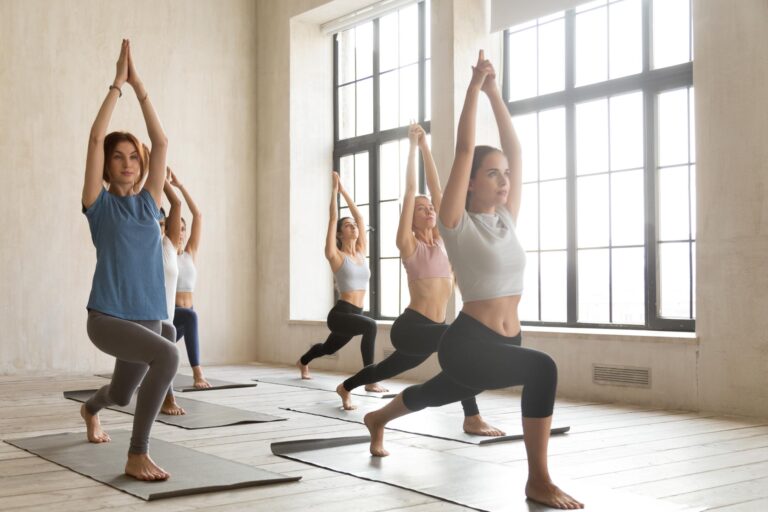With school and sports schedules, deadlines, springtime events like showers, weddings and graduations, and the anticipation of having your routine turned upside down for the long days of summer—not to mention the constant day-to-day buzzing from our phones—this time of year can make a person feel a little frazzled. “The modern world we live in today is rife with distractions and stressors,” says Jean-Carlos Jimenez, MD, medical director at Attune Wellness Med Spa, in Stamford and Greenwich, CT, as well as a board-certified family medicine doctor in the Nuvance Health network. “Stress is linked to several medical conditions and our overall mental health has suffered, especially since the COVID pandemic. Lastly, we live in a massively digital world, and this digital overload decreases our capacity for mental control. Now is the time when we need to take back control of our minds and bodies.”
To keep calm and carry on as they say, he and other experts weigh in on how to quiet our minds and find some zen.
Schedule a sensory treatment
Modalities like infrared saunas, contrast therapy, light therapy or floatation therapy are all grounding and help to restore the body and mind, says Jasmyn Pizzimbono, owner of Pause Greenwich, a franchised wellness studio that recently opened in Cos Cob, CT, offering all of these treatments and more. “These modalities offer a reset in today’s overstimulated world,” says Pizzimbono, who cites the biggest culprit to overstimulation as our phones. “As someone who’s navigated high-pressure environments in the past, I built Pause Greenwich to be the kind of space I wish I had access to—a place to reset, reconnect and truly pause.” For those who have never tried these types of treatments before, she recommends starting small with a 30-minute infrared sauna session or 10-minute LED light bed session or even a two-minute cryo session. Cryotherapy uses targeted cold temperatures for healing effect. Each of these treatments have their own physical benefits like improved circulation, reduced inflammation and sharper mental focus. But the biggest benefit, says Pizzimbono, comes with consistently pausing, as the name suggests. These practices like sauna treatments, light therapies and cold plunges, when scheduled routinely, “give us space to disconnect, recharge and reconnect with ourselves.” says Pizzimbono. “In a world that often prioritizes productivity over presence, making time to pause isn’t a luxury, it’s essential for long-term well-being.”
Volunteer your time
It may seem counterintuitive, but sometimes giving more of yourself to others in need can actually lead to feeling more grounded and peaceful, advises Katie Pfeifer, senior director of programs at Volunteer New York! “My work revolves around connecting people to meaningful volunteer opportunities and helping them discover how giving back can enrich their lives,” says Pfeifer. Volunteering for a nonprofit can “pull us out of our own heads,” she adds. Once again, Pfeifer recommends starting small. “You don’t need to commit to something huge right away to feel the benefits of volunteering.” The website allows you to search by interest, location and schedule so you can find the right fit for your lifestyle and avoid feeling like you are taking on another burdensome task. Even just once a month or one hour at a time, says Pfeifer, can be a huge benefit to the community and your own well-being, because making it part of your routine is really a form of self-care. “It grounds us in gratitude, gives us perspective and can bring a real sense of calmness and clarity,” she adds. “When you’re engaged in service, your focus shifts outward, and the internal clutter quiets. If you want to put your mindfulness into motion, volunteering is something to consider.”
Meditate
Medical journals consistently show the benefits of mindfulness meditation to reduce anxiety, depression, chronic pain and stress, attests Dr. Jimenez, from Attune Wellness Med Spa. “It teaches your brain to stay calm, focused and less reactive to stress,” he adds. “Personally, I think we can get easily lost in the day-to-day routines we have created for ourselves.” To try meditation, simply begin by focusing on your breath. Choose an anchor, such as focusing on your breathing, a body part or an ambient sound; remove judgement from your mind and if your mind begins to wander, try to focus on your breathing. “Some people feel it’s better to sit comfortably and close their eyes while doing this; others need active practices like walking meditation,” says Dr. Jimenez. Once again, the key is to start small. “Aiming for two minutes, five days a week is more realistic than a full week, but adjust your goals to what is most feasible,” says Dr. Jimenez. While you can try meditation at home for free, there are also apps available to help you get started. Beginners might find it difficult to get their mind to “shut up” so to speak. But with practice, he says, you can learn to focus. “Many of us crave instant gratification, and we may become frustrated or unmotivated if meditation doesn’t immediately calm our minds, even after the first try,” he says. “Remember to keep it simple, as this has the best chance to make it a lasting habit.”
Get outside
Numerous studies have shown getting outside and connecting with nature has a profound impact on your mental wellbeing. It’s why Christina Connors, workshop host and wellness author certified in Mindfulness-Based Stress Reduction, recommends to clients that they take walks and get outdoors on a regular basis. “As human beings, we are part of nature. When we connect with nature, we return back to that organic sense of just wellbeing,” says Connors. Additionally, as host of the children’s program Christina’s Cottage streamed on YouTube, she frequently incorporates nature into her mindfulness lessons for children and families, from planting a garden or even just a potted flower, to taking walks. “Grow an herb garden and water it together, even if you don’t have a big yard,” says Connors, whose Gratitude Garden takes on physical form on her show. “It puts you in the present moment.” She talks to clients frequently about how it’s important to calm their own minds before they help their children, and how connecting with nature can help do that. “I often ask my clients, ‘Who do you love so much you’re willing to grow for?’ and this is something I’ve learned. Children, especially the young ones, rely on us to regulate their emotions.”
Eat nutrient-rich snacks
Ava Diamond Dreyer, psychotherapist, coach and creator of Brain Optimization Coaching, serving top global law firms, hedge funds and more, uses nutritional psychology to help her patients ward off anxiety and increase calm. This doesn’t mean stress eating (impulsively eating comfort foods that are typically high in sugar and chemicals). Instead, small nutrient-dense snacks every three hours can keep blood sugar stable and give a person “healthy control” over their internal environment. This allows them to mitigate anxiety and increase a sense of calm. Properly chosen snacks digest slowly and reduce inflammation. Choose foods that increase folate intake like bananas, dark grain bread, plain yogurt with a handful of walnuts and blueberries, overnight oats with berries or a cooked sweet potato. “Small nutrient-dense snacks won’t cause a spike in blood sugar and therefore, will be well-utilized by the brain and body,” says Dreyer. If you want to up the effectiveness, couple your snack with two to 10 minutes of movement right after eating. “It will allow you to keep your body in utilization mode of the calories you consume,” she adds. Even those who may need medication to reduce anxiety will find proper nutritional intake better supports their efforts and improve the potential benefit of that medication. Dreyer customizes a nutritional psychology menu for her patients.
Listen to Music
“The essence of calming your mind is getting rid of the noise, and art in general, but particularly music, has the power to focus us on the things that matter because it is a language that is universally understood without words,” says Michael Stern, conductor of Fairfield County-based Orchestra Lumos, which performs at The Palace Theater in Stamford, CT, and travels throughout the county for performances large and small during each orchestral season. In his line of work, he sees the power music has to transport us and transform us by tapping into our humanity and our emotion and organizing the noise of the world into chords, scales and melodies. “Every person in the audience can receive what they’re hearing with as much impact and meaning as the person sitting next to them and be hearing it and receiving it in a completely different way because it’s individual to them,” says Stern. “That is the power of music has—the ability to calm us—because it instantly becomes personal. It instantly becomes something in which you can immerse yourself completely outside from your immediate or everyday reality. And it’s not escapism, it actually is a different way of processing what is happening around you.”
Stimulate your Vagus nerve
The key to all these approaches we describe, explains Erica Schwartzberg, a relational and somatic-informed psychotherapist at A Good Place Therapy in New York City, is that they all stimulate the Vagus nerve: a key part of the parasympathetic nervous system that communicates between the brain, heart and digestive systems. “Stephen Porges’ Polyvagal Theory explains how our nervous system (in particular, the Vagus nerve) responds to safety or danger, thereby influencing our behavior and emotional state,” says Schwartzberg. Stimulating this nerve, she says, offers relief in anxiety, depression and inflammation, reduces stress and improves sleep.
For a nightly routine that taps into this science, try Osea’s Vagus Nerve Pillow Mist. Osea is a brand committed to researching and formulating apothecary products that harness the healing powers of the ocean to nourish skin and improve wellbeing. Made with chamomile, lavender and juniper oils, this natural and vegan pillow mist activates this important cranial nerve, which triggers the body’s relaxation response and helps regulate stress.




